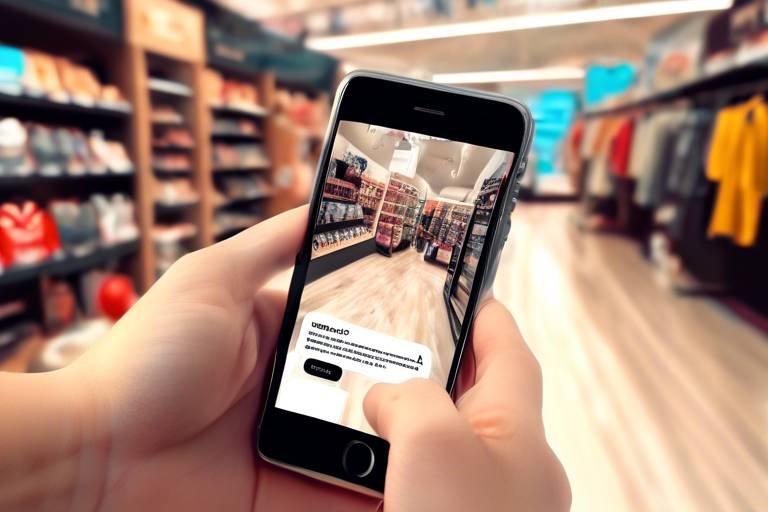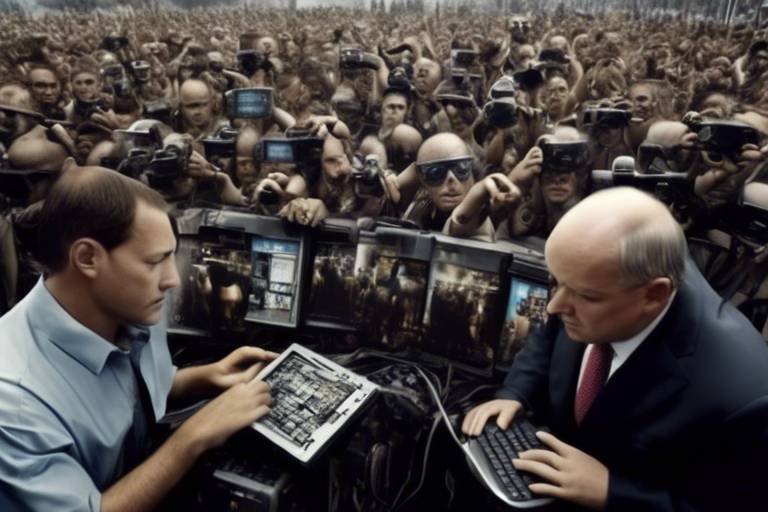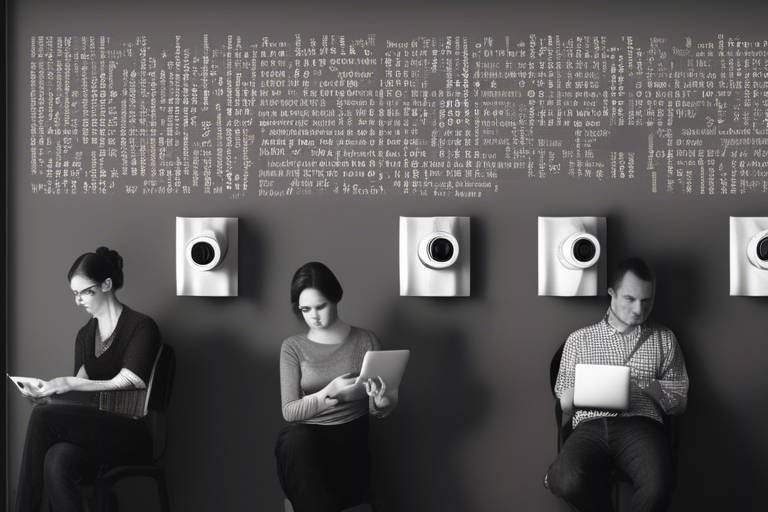How Technology is Reshaping Public Health Strategies
The landscape of public health is undergoing a remarkable transformation, driven by the rapid evolution of technology. From telemedicine to wearable devices, the integration of innovative tools into health strategies is not just a trend; it’s a revolution that is reshaping how we approach health care and disease prevention. Imagine a world where you can consult with your doctor from the comfort of your home, or where your smartwatch alerts you to potential health issues before they become serious. This is not science fiction; it’s the reality we are stepping into.
As we delve into this exciting realm, it’s essential to recognize the **transformative influence** technology has on public health strategies. One of the most significant impacts is the improvement in health outcomes. With technology, we can collect and analyze data more efficiently, leading to informed decisions that ultimately benefit communities. Moreover, technology fosters greater **community engagement** in health initiatives, empowering individuals to take charge of their health through accessible information and services.
In this article, we will explore various **innovations** that are at the forefront of this transformation. We will discuss how telemedicine is breaking barriers in healthcare access, how data analytics is reshaping public health policies, and the role of mobile health applications in empowering individuals. Additionally, we’ll look into wearable technology and its potential to revolutionize personal health monitoring. Each of these elements plays a crucial role in crafting a more responsive and effective public health strategy.
But let’s not forget the challenges that accompany these advancements. Issues such as data privacy, the need for robust infrastructure, and ensuring equitable access to technology must be addressed to fully realize the benefits. As we navigate through these complexities, it’s clear that the future of public health is intertwined with technological innovation.
So, how exactly is technology reshaping public health strategies? Let’s dive deeper into the various facets of this transformation, starting with the role of telemedicine.
Telemedicine has truly revolutionized healthcare delivery by providing remote access to medical services. Imagine being able to consult a specialist without the hassle of traveling long distances—this convenience is especially crucial for individuals in underserved areas. Telemedicine not only improves patient convenience but also expands healthcare reach, allowing for timely interventions that can save lives.
Data analytics is another game-changer in public health. By harnessing the power of data, public health officials can identify trends, allocate resources efficiently, and make informed decisions. This leads to better health outcomes for populations. For instance, during a disease outbreak, data analytics can help officials understand the spread and impact, enabling them to respond swiftly and effectively.
Predictive modeling takes data analytics a step further by utilizing historical data to forecast health trends. This proactive approach allows health officials to implement measures that can mitigate the impact of potential health crises. Imagine being able to predict a flu outbreak weeks before it happens—this foresight can lead to better preparedness and resource allocation.
Examining successful case studies demonstrates how predictive analytics has effectively guided public health responses in various regions. For example, in one city, data-driven insights led to targeted vaccination campaigns that significantly reduced the incidence of preventable diseases. These real-world examples highlight the power of data in shaping health strategies.
However, implementing predictive modeling is not without its challenges. Data privacy concerns are paramount, as individuals may be hesitant to share personal information. Additionally, the need for robust infrastructure to support data collection and analysis cannot be overlooked. Addressing these challenges is essential for maximizing the potential of predictive analytics in public health.
Real-time surveillance systems enhance the ability to monitor disease outbreaks and health trends. By facilitating quicker responses, these systems enable better resource management and can significantly reduce the impact of health emergencies.
Mobile health applications empower individuals to manage their health proactively. These applications offer tools for tracking health metrics, accessing information, and connecting with healthcare providers. Imagine having a personal health assistant in your pocket—this is the reality that mobile health apps provide.
Effective user engagement strategies are essential for the success of mobile health applications. Developers must ensure that users remain motivated and informed about their health. This could involve gamifying health tasks or providing personalized feedback, making the experience enjoyable and rewarding.
Mobile health applications play a crucial role in chronic disease management. They provide ongoing support and resources for patients to manage their conditions effectively. For instance, a diabetes management app can remind users to check their blood sugar levels and offer dietary suggestions, fostering a proactive approach to health.
Wearable technology offers continuous health monitoring, enabling individuals to track vital signs and physical activity. This constant feedback loop can lead to improved health outcomes, as users become more aware of their health patterns and can make informed lifestyle choices.
Integrating wearable technology with healthcare systems allows for seamless data sharing. This enhances patient care and facilitates timely interventions. Imagine your doctor receiving real-time updates about your health metrics—this is the future we are heading towards.
Emerging trends in wearable technology suggest advancements in functionality and accuracy. As these devices become more sophisticated, they will further revolutionize personal health monitoring, making it easier for individuals to stay on top of their health.
- What is telemedicine? Telemedicine is the use of technology to provide healthcare services remotely, allowing patients to consult with healthcare providers without needing to visit a clinic.
- How does data analytics improve public health? Data analytics helps identify health trends and allocate resources effectively, leading to better health outcomes for populations.
- What role do mobile health applications play? They empower individuals to manage their health proactively by providing tools for tracking health metrics and connecting with healthcare providers.
- What are the benefits of wearable technology? Wearable technology allows for continuous health monitoring, helping individuals track vital signs and physical activity for improved health outcomes.

The Role of Telemedicine
Telemedicine has fundamentally transformed the way we approach healthcare delivery, making it more accessible and convenient than ever before. Imagine being able to consult with a doctor from the comfort of your home, without the hassle of traveling to a clinic or waiting in long lines. This is not just a dream; it’s a reality that telemedicine has made possible. By utilizing video conferencing, mobile applications, and other digital communication tools, patients can connect with healthcare providers in real-time, regardless of their geographical location. This is especially crucial for individuals living in rural or underserved areas, where access to quality healthcare services may be limited.
One of the most significant benefits of telemedicine is its ability to improve patient convenience. With just a few clicks, patients can schedule appointments, receive diagnoses, and even get prescriptions without stepping foot outside their homes. This not only saves time but also reduces the stress associated with traditional healthcare visits. Moreover, telemedicine has proven to be a game-changer during public health crises, such as the COVID-19 pandemic, where minimizing physical contact was essential. By facilitating remote consultations, healthcare systems could continue to provide care while keeping both patients and providers safe.
Additionally, telemedicine enhances healthcare reach. It breaks down barriers that often prevent individuals from seeking medical help, such as transportation issues, long wait times, and high costs associated with in-person visits. For instance, a recent study showed that telemedicine increased access to mental health services by over 30% in areas where traditional services were scarce. This shift not only encourages more individuals to seek help but also fosters a culture of proactive health management.
However, the rise of telemedicine is not without its challenges. Issues such as internet connectivity, technological literacy, and data security must be addressed to ensure that telemedicine can reach its full potential. For example, a significant portion of the population may lack reliable internet access, making it difficult to participate in virtual consultations. Moreover, patients must feel confident in the technology they are using, which means healthcare providers need to offer support and education on how to navigate these digital platforms.
In conclusion, telemedicine is reshaping public health strategies by enhancing access, improving convenience, and fostering a more patient-centered approach to healthcare. As technology continues to evolve, it is likely that telemedicine will become an integral part of our healthcare system, paving the way for a future where quality care is available to everyone, regardless of their location.
- What is telemedicine? Telemedicine refers to the use of technology to provide healthcare services remotely, allowing patients to consult with healthcare providers without needing to visit a clinic in person.
- How does telemedicine improve access to healthcare? It enables patients in remote or underserved areas to receive medical care without the need for travel, thus overcoming geographical barriers.
- Are there any challenges associated with telemedicine? Yes, challenges include internet connectivity issues, technological literacy, and concerns regarding data privacy and security.
- Can telemedicine be used for all types of medical consultations? While telemedicine is effective for many types of consultations, it may not be suitable for all situations, especially those requiring physical examinations.

Data Analytics in Public Health
In today's fast-paced world, data analytics has emerged as a game-changer in the realm of public health. Imagine being able to sift through mountains of data to uncover hidden patterns that can save lives. That's precisely what data analytics does—it transforms raw numbers into actionable insights. Public health officials are now leveraging advanced analytics to not only identify trends but also to allocate resources more efficiently and make informed decisions that ultimately lead to better health outcomes for entire populations.
For instance, consider a scenario where a sudden spike in flu cases is detected in a specific region. With the help of data analytics, health officials can quickly pinpoint the source of the outbreak, understand its trajectory, and deploy resources where they are needed most. This proactive approach is crucial in mitigating the spread of diseases and ensuring that healthcare systems are not overwhelmed.
One of the most fascinating aspects of data analytics in public health is its ability to utilize predictive modeling. This technique takes historical data and uses it to forecast future health trends. By analyzing past outbreaks, health officials can anticipate where and when the next health crisis might occur. This foresight allows for proactive measures, such as vaccination campaigns or public awareness programs, to be implemented before a situation escalates.
Predictive modeling is akin to having a crystal ball—only it's backed by data and statistical algorithms. By examining various factors such as demographics, environmental conditions, and previous health records, public health experts can create models that predict the likelihood of diseases spreading in certain populations. This is not just theoretical; it's practical and can lead to significant improvements in public health responses.
Examining successful case studies reveals the real-world impact of predictive analytics. For example, during the Ebola outbreak in West Africa, data analytics played a pivotal role in mapping the spread of the virus. Health organizations used predictive models to identify high-risk areas, enabling them to allocate medical resources efficiently and implement containment strategies effectively. Such case studies illustrate how data-driven decisions can lead to successful public health interventions.
However, the journey to fully harness the power of data analytics is not without its challenges. One major hurdle is data privacy concerns. With the increasing amount of personal health data being collected, ensuring the confidentiality of individuals is paramount. Additionally, there is a pressing need for robust infrastructure to support data collection, storage, and analysis. Without the right systems in place, the potential of data analytics can be severely limited.
Another exciting application of data analytics is the development of real-time surveillance systems. These systems enhance the ability to monitor disease outbreaks and health trends as they happen, facilitating quicker responses and better resource management. Imagine a network of interconnected systems that can instantly relay information about a new health threat, allowing public health officials to act swiftly. This capability can be the difference between a contained outbreak and a widespread epidemic.
In conclusion, data analytics is not just a tool; it is a fundamental shift in how public health strategies are formulated and executed. By embracing data-driven approaches, health officials can make more informed decisions, ultimately leading to healthier communities. As technology continues to evolve, the integration of data analytics into public health will only deepen, paving the way for innovative solutions that can tackle the health challenges of tomorrow.
- What is data analytics in public health?
Data analytics in public health refers to the process of collecting, analyzing, and interpreting health data to inform decision-making and improve health outcomes.
- How does predictive modeling work?
Predictive modeling uses historical data to forecast future health trends, allowing public health officials to take proactive measures against potential health crises.
- What are the challenges of implementing data analytics?
Challenges include data privacy concerns and the need for robust infrastructure to support data collection and analysis.

Predictive Modeling
Predictive modeling is like having a crystal ball for public health. By analyzing historical data, health officials can forecast potential health trends and crises before they even happen. Imagine being able to predict a flu outbreak weeks in advance—this isn't just wishful thinking, it's the power of predictive analytics at work! This proactive approach allows health organizations to mobilize resources, implement preventive measures, and ultimately save lives.
The process involves sophisticated algorithms that sift through mountains of data, identifying patterns and correlations that might not be immediately obvious. For instance, factors such as weather patterns, population density, and even social media activity can be integrated into predictive models to enhance accuracy. This multifaceted analysis enables public health officials to make informed decisions that are not just reactive but also strategically proactive.
One of the key benefits of predictive modeling is its ability to allocate resources efficiently. Instead of waiting for an outbreak to occur, health departments can preemptively stockpile vaccines, deploy healthcare workers to high-risk areas, and launch awareness campaigns tailored to specific populations. This kind of foresight is invaluable, especially in times of limited resources.
To illustrate how predictive modeling can change the game, consider the following table that summarizes a few successful applications:
| Case Study | Location | Outcome |
|---|---|---|
| Flu Prediction Model | United States | Reduced flu cases by 30% through early vaccination campaigns |
| Cholera Outbreak Prediction | Bangladesh | Identified at-risk areas, leading to timely interventions and a 50% decrease in cases |
| COVID-19 Spread Forecasting | Global | Enabled countries to prepare healthcare systems for surges, reducing strain on resources |
However, it's important to note that predictive modeling isn't without its challenges. Privacy concerns regarding the data used can be a significant barrier. People are understandably wary about how their health information is collected and utilized. Moreover, the need for robust infrastructure to support these data-intensive models is crucial. If a health department lacks the necessary technology or expertise, even the best predictive model will fall flat.
In summary, predictive modeling is a game changer in public health strategy. By leveraging data to anticipate health trends, we can move from a reactive to a proactive stance in health management. Imagine a world where we not only respond to health crises but prevent them in the first place—this is the promise of predictive analytics.
- What is predictive modeling? Predictive modeling uses historical data and statistical algorithms to forecast future health trends and outcomes.
- How does predictive modeling benefit public health? It allows for proactive resource allocation, early intervention, and improved health outcomes by anticipating health crises.
- What are the challenges of implementing predictive modeling? Challenges include data privacy concerns, the need for robust infrastructure, and the complexity of accurately interpreting the data.
- Can predictive modeling be applied to all health issues? While it can be applied to many health issues, its effectiveness depends on the availability and quality of data.

Case Studies in Predictive Analytics
Predictive analytics has emerged as a game-changer in public health, enabling officials to anticipate health trends and respond effectively to emerging crises. Let's dive into some compelling case studies that illustrate the power of predictive analytics in action.
One notable example is the use of predictive modeling during the 2014 Ebola outbreak in West Africa. Public health officials utilized data from previous outbreaks to forecast the spread of the virus. By analyzing factors such as population density, travel patterns, and healthcare infrastructure, they were able to identify high-risk areas and allocate resources more effectively. This proactive approach not only helped in controlling the outbreak but also saved countless lives.
Another significant case is the Flu Near You project in the United States, which harnesses crowd-sourced data to track flu symptoms reported by individuals across the country. By analyzing this data, public health officials can predict flu outbreaks weeks in advance. The system allows for timely interventions, such as vaccination campaigns, in regions where an outbreak is anticipated. This case exemplifies how community engagement, combined with predictive analytics, can lead to better health outcomes.
Moreover, the City of Chicago has employed predictive analytics to combat gun violence. By analyzing historical crime data, socioeconomic factors, and community reports, officials can identify potential hotspots for violence. This information allows law enforcement to deploy resources more strategically and implement community programs aimed at prevention. The results have been promising, showcasing a reduction in gun-related incidents in targeted areas.
Despite these successes, the implementation of predictive analytics is not without its challenges. Data privacy concerns loom large, as individuals may be wary of how their personal information is being utilized. Additionally, the need for robust infrastructure to support data collection and analysis cannot be overstated. A well-designed system is essential for ensuring that the data is accurate and actionable.
In conclusion, these case studies underscore the transformative potential of predictive analytics in public health. By leveraging historical data and community engagement, health officials can make informed decisions that lead to proactive measures and improved health outcomes. However, as we move forward, addressing the challenges of data privacy and infrastructure will be crucial in maximizing the benefits of these innovative approaches.
- What is predictive analytics? Predictive analytics involves using historical data to forecast future health trends, enabling public health officials to take proactive measures.
- How has predictive analytics been used in public health? It has been used in various ways, including tracking disease outbreaks, allocating resources, and even crime prevention.
- What are the challenges of implementing predictive analytics? Key challenges include data privacy concerns and the need for robust data infrastructure.
- Can predictive analytics improve health outcomes? Yes, by enabling timely interventions and resource allocation, predictive analytics can significantly enhance health outcomes.

Challenges in Implementation
Despite the numerous advantages of predictive modeling in public health, implementing these advanced technologies is not without its challenges. One of the most significant hurdles is data privacy concerns. With the increasing reliance on digital data, citizens are becoming more aware of how their personal information is being used. There’s an ongoing debate about the balance between utilizing data for public good and respecting individual privacy. Public health officials must navigate this tightrope carefully to maintain public trust.
Another challenge is the need for robust infrastructure. Predictive analytics relies heavily on high-quality data, which requires sophisticated systems for data collection, storage, and analysis. Many public health departments, especially in underserved areas, may lack the necessary technological infrastructure to support these initiatives. This can lead to gaps in data availability and accuracy, ultimately hindering the effectiveness of predictive modeling.
Additionally, there’s often a knowledge gap among public health professionals regarding data analytics. While many are experts in health sciences, they may not have the technical skills necessary to interpret complex data models. This can lead to misinterpretations and poor decision-making, which can adversely affect health outcomes. To combat this issue, ongoing training and education in data science for public health workers are essential.
Finally, funding constraints pose a significant barrier to the implementation of predictive modeling. Many public health programs operate on tight budgets, and investing in new technologies can be a hard sell to stakeholders. Without adequate funding, the development and maintenance of these systems may be compromised, limiting their potential impact. Public health agencies must advocate for increased funding and demonstrate the long-term benefits of investing in predictive analytics.
In summary, while the potential of predictive modeling in public health is immense, these challenges must be addressed to fully realize its benefits. By focusing on enhancing data privacy, building robust infrastructure, bridging knowledge gaps, and securing necessary funding, public health officials can improve the effectiveness of their strategies and ultimately lead to better health outcomes for communities.
- What is predictive modeling in public health? Predictive modeling uses historical data to forecast future health trends, helping public health officials make informed decisions.
- Why is data privacy a concern in health analytics? Personal health data is sensitive, and its misuse can lead to privacy violations, making it crucial to handle such data responsibly.
- What infrastructure is needed for effective predictive modeling? A robust system for data collection, storage, and analysis is essential to ensure high-quality data is available for analysis.
- How can public health professionals improve their data analysis skills? Ongoing training and education in data science can help bridge the knowledge gap among public health workers.
- What funding options are available for public health technology initiatives? Public health agencies can seek grants, partnerships, and government funding to support technology investments.

Real-Time Surveillance Systems
In the ever-evolving landscape of public health, have emerged as a crucial tool for monitoring disease outbreaks and health trends. Imagine being able to catch a potential health crisis before it spirals out of control—this is the power that real-time surveillance brings to the table. By leveraging technology, health officials can gather and analyze data instantaneously, which significantly enhances their ability to respond to emerging threats.
These systems utilize a variety of data sources, including hospital records, laboratory results, and even social media activity, to create a comprehensive picture of public health at any given moment. This multi-faceted approach allows for quicker identification of unusual patterns that may indicate a disease outbreak. For instance, if a sudden spike in flu-like symptoms is reported in a specific area, health officials can quickly investigate and implement measures to control the spread, such as vaccination drives or public health advisories.
One of the standout features of real-time surveillance systems is their ability to facilitate data sharing among various stakeholders. This includes local health departments, hospitals, and even international organizations. By working together and sharing information, these entities can coordinate their efforts more effectively. The result? A more robust public health response that can save lives. For example, during the COVID-19 pandemic, many countries successfully utilized real-time surveillance to track the virus's spread and adapt their strategies accordingly.
However, the implementation of real-time surveillance systems is not without its challenges. Issues such as data privacy concerns and the need for advanced technology infrastructure can hinder progress. Ensuring that sensitive health information is protected while still allowing for effective monitoring is a tightrope walk that public health officials must navigate.
To illustrate the impact of real-time surveillance systems, consider the following table that highlights key benefits:
| Benefit | Description |
|---|---|
| Rapid Response | Allows health officials to act swiftly in the face of emerging threats. |
| Enhanced Coordination | Facilitates collaboration among various health entities for a unified response. |
| Data-Driven Decisions | Provides actionable insights that guide public health policies and interventions. |
In conclusion, real-time surveillance systems represent a significant leap forward in public health strategies. By harnessing the power of technology, these systems not only improve our ability to monitor health trends but also enhance our capacity to respond effectively to health crises. As we continue to innovate and refine these systems, the potential for improved health outcomes becomes even more promising.
- What are real-time surveillance systems?
Real-time surveillance systems are tools that allow health officials to monitor disease outbreaks and health trends using data collected from various sources instantaneously. - How do these systems improve public health responses?
By providing immediate insights into health trends, they enable quicker decision-making and coordinated responses to emerging health threats. - What challenges do real-time surveillance systems face?
Challenges include data privacy concerns and the need for robust technological infrastructure to support data collection and analysis.

Mobile Health Applications
In today's fast-paced world, have emerged as a game-changer in the way we manage our health. These innovative tools are not just about convenience; they empower individuals to take charge of their health like never before. Imagine having a personal health assistant right in your pocket, available 24/7. That's the reality for millions of users who have embraced these applications. From tracking daily activity to monitoring chronic conditions, mobile health apps are reshaping the healthcare landscape.
One of the most significant benefits of mobile health applications is their ability to provide real-time data. Users can easily track vital health metrics such as heart rate, blood pressure, and even sleep patterns. This constant monitoring not only helps individuals stay informed about their health but also enables healthcare providers to make better-informed decisions. For instance, a patient with diabetes can log their blood sugar levels and share this information with their doctor, leading to more personalized treatment plans.
Moreover, these applications often come equipped with educational resources, offering users valuable information about their health conditions. This feature is particularly beneficial for those managing chronic diseases. By having access to a wealth of knowledge at their fingertips, users can become more proactive in their health management. They can learn about dietary changes, exercise routines, and medication adherence, all of which are crucial for maintaining optimal health.
However, the success of mobile health applications hinges on user engagement. It's not enough to simply download an app; users must be motivated to use it consistently. Developers are increasingly focusing on creating engaging user experiences through features like gamification, reminders, and social sharing. For example, some apps reward users for meeting their health goals, which can significantly boost motivation. Additionally, integrating social features allows users to connect with friends and family, creating a supportive community that encourages healthy behaviors.
Another vital aspect of mobile health applications is their role in chronic disease management. For individuals living with conditions like hypertension or asthma, these apps provide ongoing support and resources. Users can receive medication reminders, track symptoms, and even access telehealth services for consultations with healthcare professionals. This level of support can lead to better adherence to treatment plans and ultimately improve health outcomes.
As we look to the future, the potential for mobile health applications is immense. With advancements in technology, we can expect to see even more features that enhance user experience and health management. Imagine apps that use artificial intelligence to provide personalized health recommendations based on user data or applications that can seamlessly integrate with wearable devices for a comprehensive view of health metrics. The possibilities are exciting and endless!
- What are mobile health applications? Mobile health applications are digital tools designed to help individuals manage their health through features like tracking metrics, accessing information, and connecting with healthcare providers.
- How can mobile health apps improve my health? These apps promote proactive health management by providing real-time data, educational resources, and support for chronic disease management.
- Are there any challenges with using mobile health applications? Some challenges include ensuring user engagement, data privacy concerns, and the need for reliable internet access.
- Can mobile health applications replace traditional healthcare? While they offer valuable support, mobile health applications are intended to complement traditional healthcare, not replace it.

User Engagement Strategies
User engagement is the heartbeat of mobile health applications. It's not just about downloading an app; it's about keeping users actively involved and motivated to manage their health. Think about it: how many times have you downloaded an app only to forget about it a week later? The challenge lies in creating an experience that resonates with users, making them feel empowered and informed about their health journey. To achieve this, developers and health organizations must implement effective user engagement strategies that go beyond the basics.
One of the most effective strategies is to incorporate personalization. When users see content and features tailored to their specific needs, they are more likely to engage regularly. For instance, if a user has diabetes, the app could provide customized meal plans, medication reminders, and relevant articles. This not only enhances the user experience but also fosters a sense of ownership over their health.
Another key strategy is to utilize gamification. By introducing game-like elements, such as challenges, rewards, and progress tracking, users can find motivation in their health activities. Imagine earning points for daily step goals or receiving badges for consistent medication adherence. This approach not only makes health management more enjoyable but also encourages users to stay committed to their goals.
Furthermore, community engagement plays a vital role in user retention. Users are more likely to remain engaged when they feel part of a community. Integrating social features, such as forums or support groups, allows users to share experiences, challenges, and successes. This sense of belonging can be incredibly motivating, as individuals realize they are not alone in their health journeys.
Regular feedback loops are also crucial. Mobile health applications should provide users with the opportunity to give feedback on their experience. This can be done through surveys or in-app prompts. By listening to users and making necessary adjustments, developers can create a more user-friendly experience that meets the evolving needs of the audience.
To illustrate the impact of these strategies, consider the following table showcasing different user engagement tactics and their benefits:
| User Engagement Strategy | Benefits |
|---|---|
| Personalization | Increases relevance and user satisfaction |
| Gamification | Enhances motivation and retention |
| Community Engagement | Fosters support and shared experiences |
| Feedback Loops | Improves user experience through continuous improvement |
In conclusion, user engagement strategies are not just an afterthought; they are essential for the success of mobile health applications. By focusing on personalization, gamification, community engagement, and feedback, developers can create a more enriching experience that keeps users coming back. After all, the ultimate goal is to empower individuals to take charge of their health and make informed decisions every step of the way.
- What is the importance of user engagement in mobile health applications? User engagement is crucial as it ensures that users remain active and motivated to manage their health, leading to better outcomes.
- How can personalization improve user experience? Personalization makes the app more relevant to individual users, enhancing satisfaction and encouraging regular use.
- What role does gamification play in health apps? Gamification introduces fun elements that motivate users to achieve health goals, making the process enjoyable.
- How can community features enhance engagement? Community features provide support and a sense of belonging, encouraging users to share their journeys and stay committed.

Impact on Chronic Disease Management
Chronic diseases, such as diabetes, heart disease, and asthma, are among the leading causes of morbidity and mortality worldwide. Managing these conditions can be a daunting task for patients and healthcare providers alike. However, mobile health applications are stepping in to transform chronic disease management by providing innovative tools that empower patients to take charge of their health. Imagine having a personal health assistant right in your pocket; that’s exactly what these apps offer!
These applications allow users to track their health metrics, such as blood sugar levels, blood pressure, and physical activity. This real-time data collection not only helps patients stay informed about their conditions but also enables healthcare providers to monitor their patients’ health remotely. For instance, a diabetes management app can send alerts when a patient's blood sugar levels are too high or too low, prompting immediate action. This proactive approach can significantly reduce the risk of complications associated with chronic diseases.
Moreover, mobile health applications often feature educational resources that help users understand their conditions better. By providing access to articles, videos, and forums, these apps foster a sense of community and support among users. Patients can share their experiences, tips, and strategies for managing their conditions, creating a network of encouragement and motivation. It’s like having a support group at your fingertips!
Additionally, many mobile health applications integrate with wearable technology, allowing for continuous health monitoring. For example, a smartwatch can track a user’s heart rate and activity levels, syncing this information with a corresponding health app. This integration not only enhances the accuracy of data but also provides a comprehensive view of a patient’s health, facilitating more informed decision-making by healthcare providers.
However, while the benefits of mobile health applications in chronic disease management are substantial, there are challenges to consider. Issues such as data privacy, user engagement, and the digital divide can hinder the widespread adoption of these technologies. Patients must feel confident that their health data is secure, and developers need to create intuitive interfaces that encourage regular use. Furthermore, not everyone has equal access to smartphones or the internet, which can exacerbate health disparities.
In conclusion, mobile health applications are revolutionizing the management of chronic diseases by providing tools that enhance patient engagement, facilitate real-time monitoring, and promote education. As technology continues to evolve, the potential for these applications to improve health outcomes will only grow. The future of chronic disease management is bright, and it’s all thanks to the power of technology!
- What are mobile health applications? Mobile health applications are software programs designed to help users manage their health and wellness through features like tracking health metrics, providing educational resources, and connecting with healthcare providers.
- How do mobile health apps benefit chronic disease management? They empower patients by offering tools for real-time tracking, education, and community support, which can lead to better health outcomes and reduced complications.
- Are there any challenges with mobile health applications? Yes, challenges include data privacy concerns, the need for user engagement, and disparities in access to technology.
- Can wearable technology integrate with mobile health apps? Absolutely! Many mobile health applications can sync data from wearable devices, providing a more comprehensive view of a user’s health.

Wearable Technology in Health Monitoring
In today's fast-paced world, wearable technology has emerged as a game-changer in health monitoring. From smartwatches to fitness trackers, these innovative devices are not just fashion statements; they are powerful tools that enable individuals to take charge of their health. Imagine having a personal health assistant strapped to your wrist, constantly monitoring your vital signs and activity levels! This technology is revolutionizing the way we approach health management, providing real-time data that can lead to better health outcomes.
One of the most significant advantages of wearable technology is its ability to offer continuous health monitoring. Unlike traditional methods that often rely on periodic check-ups, wearables provide a constant stream of data, allowing users to track their heart rate, sleep patterns, and even stress levels throughout the day. This continuous feedback loop empowers individuals to make informed decisions about their health, whether it’s adjusting their exercise routine or seeking medical advice when anomalies are detected.
Moreover, the integration of wearable technology with healthcare systems has enhanced patient care dramatically. When wearables sync with healthcare providers, they facilitate seamless data sharing, ensuring that doctors have access to accurate and up-to-date information. This integration not only improves the quality of care but also allows for timely interventions. For example, if a patient’s heart rate spikes unexpectedly, their healthcare provider can be alerted immediately, potentially preventing a serious health crisis.
As we look to the future, the trends in wearable technology are incredibly promising. With advancements in functionality and accuracy, we can expect devices that not only monitor physical activity but also analyze complex health metrics. Imagine a wearable that can detect early signs of diabetes or cardiovascular issues! The potential for these technologies to transform personal health monitoring is immense, and they are likely to become an integral part of our daily lives.
However, while the benefits of wearable technology are clear, it is essential to acknowledge the challenges that come with it. Issues such as data privacy and the need for robust infrastructure are critical considerations that must be addressed. Users must feel confident that their personal health data is protected and used responsibly. As we continue to innovate, ensuring the security of this information will be paramount.
In conclusion, wearable technology is not just a trend; it is a significant advancement in health monitoring that has the potential to enhance individual health management and improve healthcare delivery. As these devices evolve, they will undoubtedly play an essential role in shaping the future of public health strategies.
- What types of wearable technology are available for health monitoring? There are various types of wearables, including smartwatches, fitness trackers, and biosensors that monitor heart rate, sleep, and physical activity.
- How accurate are wearable health devices? While many wearables provide reasonably accurate data, their accuracy can vary. It's essential to choose reputable brands and understand the limitations of each device.
- Can wearable technology replace traditional healthcare? Wearable technology is a supplement to traditional healthcare; it enhances monitoring and data collection but does not replace the need for professional medical advice and treatment.
- What are the privacy concerns associated with wearable technology? Privacy concerns include data security, unauthorized access to personal health information, and how data is used by companies. Users should familiarize themselves with privacy policies and choose devices that prioritize data protection.

Integration with Healthcare Systems
Integrating wearable technology with healthcare systems is like connecting the dots in a complex puzzle. When these two worlds collide, they create a seamless flow of information that can significantly enhance patient care. Imagine a scenario where your smartwatch not only tracks your heart rate but also sends real-time data to your doctor. This integration means that healthcare providers can monitor patients proactively, making timely interventions when necessary. It transforms the traditional model of healthcare from reactive to proactive, allowing for a more personalized approach to treatment.
The integration process involves several key components, including:
- Data Synchronization: Wearable devices must be able to sync data with electronic health records (EHRs) to ensure that healthcare providers have access to the most current information. This real-time data exchange is crucial for effective monitoring and decision-making.
- Interoperability: Different healthcare systems and wearable devices need to communicate with each other. Achieving interoperability allows for a holistic view of a patient's health, enabling providers to see patterns and trends that may not be visible from isolated data points.
- Patient Engagement: When patients are involved in their health management through wearable devices, they tend to be more engaged in their treatment plans. This engagement is amplified when healthcare systems provide feedback based on the data collected, fostering a collaborative environment.
Moreover, the integration of wearable technology with healthcare systems can lead to better chronic disease management. For instance, a patient with diabetes can use a glucose monitor that syncs with their healthcare provider's system, allowing for real-time adjustments in medication or lifestyle recommendations. This not only empowers patients but also reduces the burden on healthcare facilities by minimizing unnecessary visits.
However, the journey towards seamless integration is not without its challenges. Issues such as data privacy, security concerns, and the need for robust infrastructure must be addressed. Healthcare providers need to ensure that patient data is protected while still being accessible for necessary healthcare decisions. This delicate balance is essential for building trust between patients and healthcare systems.
In conclusion, the integration of wearable technology with healthcare systems is a game-changer in modern healthcare. It enhances communication, improves patient outcomes, and fosters a more engaged patient population. As technology continues to evolve, we can expect even more innovative solutions that will further bridge the gap between personal health monitoring and professional healthcare delivery.
- What types of wearable technology are commonly integrated with healthcare systems?
Common types include fitness trackers, smartwatches, and medical devices like heart rate monitors and glucose sensors. - How does data privacy work with wearable technology?
Data privacy is managed through encryption and strict compliance with regulations such as HIPAA to protect patient information. - Can wearable technology replace traditional healthcare visits?
While wearable technology enhances monitoring, it is not a replacement for traditional healthcare visits; rather, it complements them by providing valuable data.

Future Trends in Wearables
The landscape of wearable technology is evolving at a breakneck pace, and the future promises even more exciting advancements. Imagine a world where your smartwatch not only tracks your steps but also detects early signs of health issues before they escalate. This is not just a dream; it’s a reality on the horizon. As we delve into the future trends in wearables, we can expect innovations that enhance functionality, improve accuracy, and integrate seamlessly with our daily lives.
One significant trend is the **integration of artificial intelligence (AI)** into wearable devices. AI algorithms will enable wearables to analyze data more intelligently, providing personalized health insights and recommendations. For instance, your fitness tracker might suggest tailored workout plans based on your activity levels, sleep patterns, and even stress indicators. This level of personalization can significantly enhance user engagement and motivate individuals to take control of their health.
Moreover, the **advancement of biosensors** is set to revolutionize how we monitor our health. Future wearables will likely feature advanced biosensors capable of tracking a wider array of health metrics, including blood glucose levels, hydration status, and even hormonal fluctuations. This capability will empower users, particularly those managing chronic conditions, to gain deeper insights into their health without the need for invasive procedures.
In addition to improved functionalities, we can also anticipate a shift towards **greater interoperability** among devices. As more health applications and wearables emerge, the ability to share data across platforms will become crucial. Imagine this: your smartwatch communicates with your smart scale, which in turn syncs with your nutrition app to provide a comprehensive view of your health. This interconnectedness will not only enhance user experience but also allow healthcare providers to access a holistic view of a patient’s health, leading to better-informed decisions.
Another exciting trend is the **increasing focus on mental health**. Wearables are beginning to incorporate features that monitor not just physical health but also mental well-being. Devices may soon offer tools for stress management, meditation guidance, and even mood tracking, providing users with a more rounded approach to health. This holistic focus aligns with the growing recognition of mental health as a critical component of overall wellness.
As we look to the future, **sustainability** will also be a key consideration in wearable technology. Manufacturers are increasingly recognizing the importance of environmentally friendly practices. We can expect to see wearables made from sustainable materials, with a focus on energy efficiency and recyclability. This not only benefits the planet but also resonates with consumers who are becoming more eco-conscious.
To summarize, the future of wearable technology is bright and full of potential. With advancements in AI, biosensors, interoperability, mental health features, and sustainability, we are on the brink of a new era in personal health monitoring. These innovations will not only enhance individual health outcomes but also contribute to a more connected and informed society.
- What are wearable technologies? Wearable technologies are electronic devices that can be worn on the body, often used to track health metrics and provide fitness insights.
- How can wearables help in chronic disease management? Wearables can monitor vital signs and health metrics continuously, providing real-time data that helps patients manage their conditions effectively.
- What future advancements can we expect in wearable technology? Future advancements include AI integration, enhanced biosensors, interoperability between devices, mental health monitoring features, and a focus on sustainability.
- Are wearables safe to use? Yes, wearables are generally safe, but it’s essential to choose reputable brands and consult healthcare professionals if you have specific health concerns.
Frequently Asked Questions
- What is telemedicine and how does it benefit public health?
Telemedicine is a method of delivering healthcare services remotely using technology. It allows patients to consult with healthcare providers via video calls or phone calls, making healthcare more accessible, especially in rural or underserved areas. This approach not only enhances patient convenience but also helps in reducing the burden on healthcare facilities.
- How does data analytics improve public health strategies?
Data analytics plays a crucial role in public health by helping officials identify health trends and allocate resources more effectively. By analyzing large datasets, public health professionals can make informed decisions that lead to better health outcomes for communities, ensuring that interventions are timely and targeted.
- What is predictive modeling and why is it important?
Predictive modeling uses historical data to forecast future health trends, allowing public health officials to take proactive measures against potential health crises. This can be particularly important for preparing for outbreaks or managing resources during emergencies.
- What challenges are faced in implementing predictive modeling?
While predictive modeling offers significant benefits, challenges include concerns about data privacy and the need for robust technological infrastructure. Ensuring that data is secure while being accessible for analysis is a critical hurdle that needs to be addressed.
- How do real-time surveillance systems enhance public health responses?
Real-time surveillance systems allow for continuous monitoring of disease outbreaks and health trends, enabling quicker responses from health authorities. This capability ensures that resources can be managed effectively and that interventions can be deployed swiftly to mitigate health risks.
- What role do mobile health applications play in chronic disease management?
Mobile health applications help individuals manage chronic diseases by providing tools for tracking health metrics, accessing educational resources, and connecting with healthcare providers. This ongoing support empowers patients to take control of their health and improve their quality of life.
- What strategies can improve user engagement in mobile health applications?
Effective user engagement strategies include personalized notifications, gamification elements, and educational content that keeps users motivated and informed. By making the app experience enjoyable and relevant, users are more likely to stay engaged with their health management.
- How does wearable technology contribute to health monitoring?
Wearable technology, such as fitness trackers and smartwatches, provides continuous health monitoring by tracking vital signs and physical activity. This data can lead to better health outcomes by encouraging individuals to stay active and alerting them to potential health issues.
- What are the future trends for wearable health technology?
Emerging trends in wearable technology suggest advancements in functionality, such as improved accuracy in tracking health metrics and integration with healthcare systems. These developments will enhance personal health monitoring and support more personalized healthcare solutions.



















